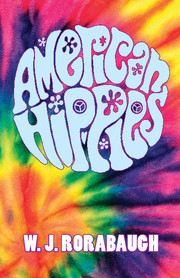Introduction
Published online by Cambridge University Press: 05 June 2015
Summary
Suddenly, in 1966 there were hippies, thousands of them, then tens of thousands, and within a couple of years, hundreds of thousands, or even millions of long-haired youth of both sexes dressed in tight-fitting jeans or bright-colored pants accompanied by colorful tie-dyed T-shirts with or without printed slogans, or, in the case of a goodly number of women, wearing Victorian “granny dresses” either out of the attic or from a chic store. The clothing, by contemporary standards, was outrageous. For men, slender pants flaunted sexuality in a traditionally repressed culture, while hip-swinging bejeaned women turned men on by wearing low-cut blouses and going braless. Hippie men and their “chicks” gave heightened display to the body from the red bandannas they wrapped around the forehead, to beads or Indian jewelry draped around the neck, to thick homemade leather belts with gigantic steel buckles, to sockless sandals made cheaply from recycled tires and imported from Mexico. As visibly different from mainstream culture as possible, they could not be ignored.
The hippie counterculture is historically important for several reasons. First, this counterculture was a significant part of the massive upheavals of the 1960s, which included civil rights, Black Power, feminism, and gay liberation, as well as looser sexual mores, the end of censorship, street protests, political radicalism, and environmentalism. Collectively, these movements profoundly changed the United States. Second, the hippie counterculture was large. Hundreds of thousands of young Americans were, at least for a time, hippies, and millions adopted some if not all hippie beliefs and practices. The numbers mattered. Third, hippie values represented a generational break with traditional middle-class culture. When hordes of people concentrated in a single youth generation simultaneously adopted new thoughts and behaviors, mainstream culture was forced to pay attention. In the long run, hippies played a significant role in transforming American society.
- Type
- Chapter
- Information
- American Hippies , pp. 1 - 14Publisher: Cambridge University PressPrint publication year: 2015



